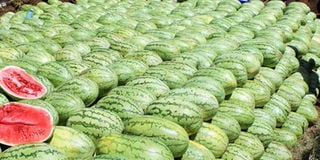Ask your Agronomist: For high yields from water melon, use these fertilisers

Watermelons displayed for sale. High quality melon fruits are characterised by a deep red colour inside, with a high sugar content of 10-14 per cent. FILE PHOTO | NATION MEDIA GROUP
What you need to know:
- Being a shallow rooted crop, melons will not do well in waterlogged or too dry soils, as these conditions will increase incidents of fruit cracking.
- Application of fertilisers that offer a balanced nutrient supply giving both primary, secondary and micro-nutrients is critical for high yields and quality melons.
- Too much nitrogen fertilisers during and after flowering should also to be avoided as this will reduce flowering and fruit set, and, therefore, lower yields.
- Fertiliser application for melons should, therefore, start by the first week after transplanting, with an NPK regime such as UNIK 17 for establishment of the crop.
Q: I am a watermelon farmer in Kibwezi, Makueni County. Please advise me on the best fertiliser products to use for me to produce good quality yields.
Like many other crops, melon production requires a careful look at the nutrition practices as well as proper management of other agronomic factors.
Best, high-yielding melons are produced with good balanced nutrition in well-drained, deep soils with an optimum pH range of 6.0–6.6.
High quality fruits are characterised by a deep red colour inside, with a high sugar content of 10-14 per cent.
Being a shallow rooted crop, melons will not do well in waterlogged or too dry soils, as these conditions will increase incidents of fruit cracking.
Shallow sandy soils are, therefore, ideal for melon production.
Influencing yield and quality
Application of fertilisers that offer a balanced nutrient supply giving both primary, secondary and micro-nutrients is critical for high yields and quality melons.
NPK fertilisers high in P such as UNIK 17 are important for initial crop establishment while a good N supply will ensure vigorous growth.
It is important to note that melons do not respond well to ammonium forms of nitrogen, as this may restrict growth and reduce quality.
So avoid fertilisers such as urea and ammonium sulphate and other ammonium N type fertilisers in melons.
Too much nitrogen fertilisers during and after flowering should also to be avoided as this will reduce flowering and fruit set, and, therefore, lower yields.
Melons like tomatoes are susceptible to physiological disorders such as blossom end rot. As such ensure supply of a soluble calcium as well as boron to minimize this risk.
Fertilisation regime
Fertiliser application for melons should, therefore, start by the first week after transplanting, with an NPK regime such as UNIK 17 for establishment of the crop.
As stated, melons prefer a nitrate form of nitrogen as opposed to ammonium forms, and, therefore, nitrate N source fertilisers such as in YaraMila Winner and Nitrabor for topdressing will give better results, that is, high yields of a higher quality.
For crop specific fertiliser recommendations, please consult the following agronomists in your area:
Western and Nyanza, Daniel Mui, 0702466343.
Rift Valley, Dennis Nyandaya, 0702466372.
Central, Robert Ngatia, 0702466318.
Vitalis Wafula, Yara East Africa Regional Agronomist




